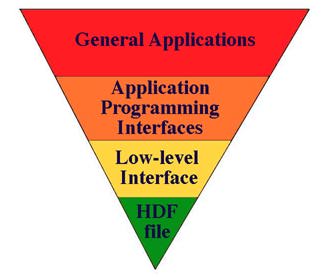Please see The HDF Group's new Support Portal for the latest information.
 At its lowest level, HDF is a physical file format for storing
scientific data. At its highest level, HDF is a collection of
utilities and applications for manipulating, viewing, and
analyzing data in HDF files. Between these levels, HDF is a
software library that provides high-level APIs and a low-level
data interface.
At its lowest level, HDF is a physical file format for storing
scientific data. At its highest level, HDF is a collection of
utilities and applications for manipulating, viewing, and
analyzing data in HDF files. Between these levels, HDF is a
software library that provides high-level APIs and a low-level
data interface.
General Applications
- At the highest level are HDF command-line utilities,
The HDF Group applications that support data visualization and analysis,
and a variety of third-party applications.
There are HDF command line utilities to:
- convert from one format to another (for eg. to and from JPEG/HDF)
- analyze and view HDF files (hdp being one of the more useful tools)
- manipulate HDF files
Please refer to the What Software uses HDF? page for more information.
The Application Programming Interfaces
- These include sets of routines for storing and accessing a specific
type of data. Although each interface (Application Programming Interface or API)
requires programming, all the low-level details can be ignored. These are
available in both C and Fortran.
The data structure types that HDF supports are Scientific Data Sets (SD and DFSD APIs), Raster Images (General, 8-bit, 24-bit APIs), color palettes, text entries, and Vdatas and Vgroups.
The Low-level Interface
- This interface is reserved for software developers. It was designed
for direct file I/O of data streams, error handling, memory management, and
physical storage. It is essentially a software toolkit for skilled
programmers who wish to make HDF do something more than what is
currently available through the higher-level interfaces. Low-level
routines are only available in C.
- - Last modified: 27 January 2017

